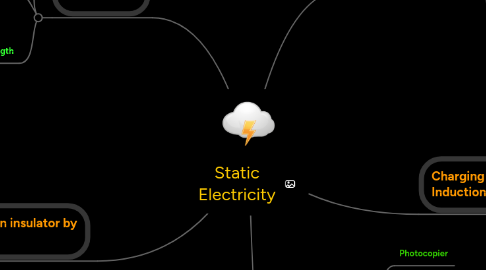
1. Electric field
1.1. Defination
1.1.1. A region in which charged particles experiences an electric force
1.2. Determine direction of field
1.2.1. Positive test charge used
1.2.2. Draw field lines represent elec. field
1.2.3. Arrow
1.2.3.1. Direction movement positive test charge
1.3. Strength
1.3.1. Nearer
1.3.1.1. stronger
1.3.2. Further
1.3.2.1. Weaker
2. Charging an insulator by friction
2.1. Friction
2.1.1. Rubbing
2.2. insulator
2.2.1. Electron are not able to flow within it
2.3. how does it work
2.3.1. two objects rub together
2.3.1.1. electron weaker bond from one material transfer to another
2.4. Discharging charged insulator
2.4.1. Heating
2.4.2. Humid conditions
3. Electric Charges
3.1. Atom
3.1.1. Electrically Neutral
3.1.2. contains
3.1.2.1. Neutron
3.1.2.2. Proton (+)
3.1.2.3. Electron (-)
3.1.2.3.1. Gain
3.1.2.3.2. Lose
3.2. Charges
3.2.1. Unlike
3.2.1.1. Attracts
3.2.1.2. Example
3.2.1.2.1. Positive-Negative
3.2.2. Like
3.2.2.1. Repels
3.2.2.2. Example
3.2.2.2.1. Positive-Positive
3.2.2.2.2. Negative-negative
3.2.3. Measured in
3.2.3.1. Coulombs
3.2.3.1.1. Positive charge
3.2.3.1.2. Negative charge
4. Charging conductor by Induction
4.1. Charging without coming into direct contact
4.2. Conductor
4.2.1. Electron free to move about within it
4.2.2. Metals
4.2.3. Connected to ground wire
4.2.3.1. allow electron to move up down from the conductor
5. Applications
5.1. Photocopier
5.2. Laser printer
5.3. Potential hazards
5.3.1. Lightning
5.3.2. Fires and Explosions
5.3.2.1. Pumping of oil into aircraft
5.3.2.2. Truck carrying flammable substance
